Bosley Estates Designed to Fail?
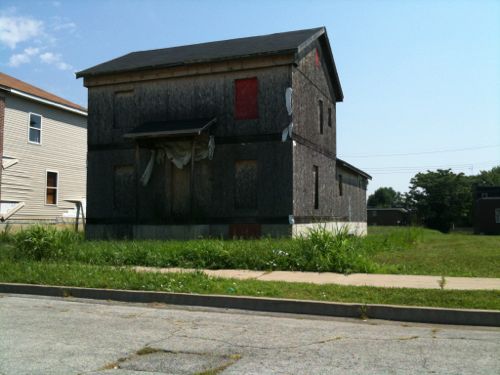
Last week I was driving through North St Louis and I checked out the progress on Bosley Estates, named for 3rd ward alderman Freeman Bosley Sr. Only seven houses were ever started with four finished, sold, and occupied. The other three were never finished, including 3912 N. 22nd. Â Of course, one could say this should be expected given the current economy.
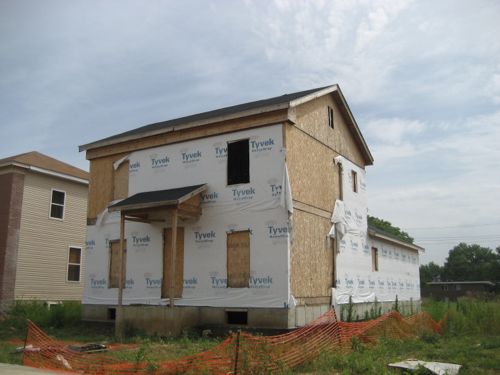
When I visited Bosley Estates on June 27, 2007 it was clear to me the development was going to flop.  True, one of the finished houses had just sold for $155,200.00 on 02/07/2007.  Another would sell for $167k in October of 2007.
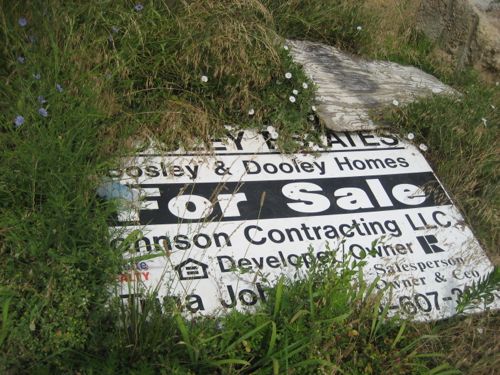
Ground was broken on Bosley Estates in December 2005, the project was to include 150 new homes. But nearly two years later it was clearly no longer a priority.
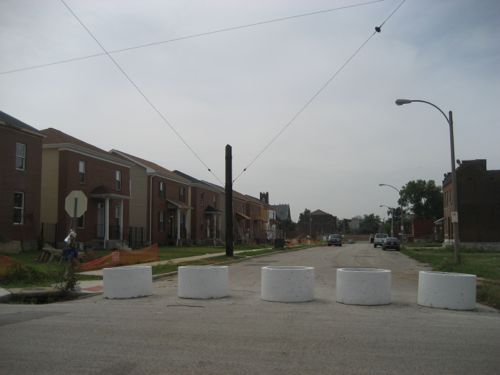
The street grid no longer functions as designed in much of the city, especially in the 3rd ward.
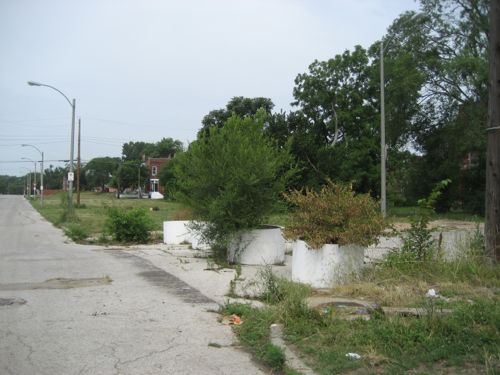
Interestingly, one of the four homes finally sold on 03/08/2010 for $133,500.00. Â I’m shocked.
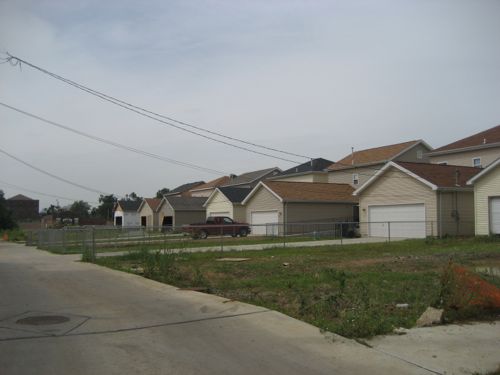
One of the biggest flaws of so many new homes built in the city is the attached garage and long driveway. Â Proponents claim the attached garage is safer, not having to go outside to go from house to car. Â But owners must still get out of their cars in the alley to open the fence gate. Rather than have a nice backyard enclosed by a detached garage, these houses have concrete.
The Comptroller’s office looked at the developer, Minority Developers and Builders Association, LLC, in December 2007 – see the report here. Â St. Louis Patina blogged about this development in May 2009. When I first visited in June 2007, just 18 months after groundbreaking, it was clear to me it was sinking then. Now, more than four years after my original visit it would appear St. Louis has wasted money on another failed project.
– Steve Patterson
What public funds were used for the project? I couldn’t tell from your post, and I’d never heard of this development before.
What public funds were used for the project? I couldn’t tell from your post, and I’d never heard of this development before.
Yes, but I don’t know how much. The development was nothing more than slapping on a name to existing building lots.
Yes, but I don’t know how much. The development was nothing more than slapping on a name to existing building lots.
nice digging, steve. It looks like the contract amount was $200,000 from the Affordable Housing Commission.  Some questions to the AHC about how they make decisions on how to distribute funds would be the next step. At least, AHC needs to answer why they authorized public funds to an agency, according to the Comptroller report, had run afoul of CDA/SLDC previously. It sounds like Bosley wanted to give a friend some money, could not do so through CDA/SLDC because of the developer’s shitty record, and so went to AHC to get around the CDA ban.
nice digging, steve. It looks like the contract amount was $200,000 from the Affordable Housing Commission. Some questions to the AHC about how they make decisions on how to distribute funds would be the next step. At least, AHC needs to answer why they authorized public funds to an agency, according to the Comptroller report, had run afoul of CDA/SLDC previously. It sounds like Bosley wanted to give a friend some money, could not do so through CDA/SLDC because of the developer’s shitty record, and so went to AHC to get around the CDA ban.
I can’t speak to Bosley’s motivations. There may be other money involved too, the alley has new concrete, sewers may have been replaced, tax abatement, etc. Hopefully a local reporter will dig further into Bosely’s poor track record.
I can’t speak to Bosley’s motivations. There may be other money involved too, the alley has new concrete, sewers may have been replaced, tax abatement, etc. Hopefully a local reporter will dig further into Bosely’s poor track record.
Now this is what HUD is talking about people abuseing the funds,I want to know where did the rest of the money go to complete these homes.This is a sad site……I would love help change all of this…..I smellla BIG RAT.
Now this is what HUD is talking about people abuseing the funds,I want to know where did the rest of the money go to complete these homes.This is a sad site……I would love help change all of this…..I smellla BIG RAT.
Not surprising. I hate to say it but why is it some minorities in power feed off each other. Nice that homes were built and then left to destroy whats left of the neighborhood.  If I brought one of those homes I would feel screwed. BTW….a 3 foot fence will not stop an intruder one bit.
Not surprising. I hate to say it but why is it some minorities in power feed off each other. Nice that homes were built and then left to destroy whats left of the neighborhood. If I brought one of those homes I would feel screwed. BTW….a 3 foot fence will not stop an intruder one bit.
#1 rule in real estate? Location, location, location . . . . .
#1 rule in real estate? Location, location, location . . . . .
Convenient excuse for doing nothing. The problem is the location wasn’t improved, just adding a few new houses without addressing other problems.
No, location is a big issue – location dictates price. Put these same, identical houses in Arnold or St. Peters or Fairview Heights and they would sell for more, without any direct subsidies from any of these cities. Put them in the suburbs of New York City or Chicago and they would sell for twice as much. Put them in Silicon Valley and they would sell for three times as much.
You say “the location wasn’t improved”. I agree, the surrounding neighborhood remained/remains unchanged. Whose responsibility is that? The developer’s? The city’s? The school system’s? The neighbors / current residents’? The state government’s? The federal government’s? And how far do we need to go / improve? Two blocks? 10? 20? 50? We, the people of St. Louis, Missouri and the USA did not run these properties / blocks into the ground, to the point where they need to rebuilt from the ground up. The current and previous residents / owners are the ones that skimped on maintenance, turning what was once a “nice” neighborhood 75 years ago into the basket case it is today.
Don’t get me wrong, I’m not against someone having a decent roof over their head, nor do I think that all subsidies are wrong. I just see a real problem investing in islands; we’d be much better off working from the outside in. Stabilize and support neighborhoods that are currently in good shape, and work to improve the nearby neighborhoods that need help incrementally. You’re right, this was good for an alderman’s ego and a few of his buddies, but as a game changer to help the larger neighborhood? Not so much . . . .
Good point JZ, but at what point do those surrounding neighborhoods say ‘we’re good now, you can move on’ None, not even Ladue will ever say we are stabalized enough, especially if there is free money to be had. But yes, people need to take care of their own hoods…take pride in them, report crime, etc.
Convenient excuse for doing nothing. The problem is the location wasn’t improved, just adding a few new houses without addressing other problems.
Attached garages and long driveways did not cause this project to fail.
Attached garages and long driveways did not cause this project to fail.
No, location is a big issue – location dictates price. Put these same, identical houses in Arnold or St. Peters or Fairview Heights and they would sell for more, without any direct subsidies from any of these cities. Put them in the suburbs of New York City or Chicago and they would sell for twice as much. Put them in Silicon Valley and they would sell for three times as much.
You say “the location wasn’t improved”. I agree, the surrounding neighborhood remained/remains unchanged. Whose responsibility is that? The developer’s? The city’s? The school system’s? The neighbors / current residents’? The state government’s? The federal government’s? And how far do we need to go/improve? Two blocks? 10? 20? 50? We, the people of St. Louis, Missouri and the USA did not run these properties / blocks into the ground, to the point where they need to rebuilt from the ground up. The current and previous residents / owners are the ones that skimped on maintenance, turning what was once a “nice” neighborhood 75 years ago into the basket case it is today.
Don’t get me wrong, I’m not against someone having a decent roof over their head, nor do I think that all subsidies are wrong. I just see a real problem investing in islands; we’d be much better off working from the outside in. Stabilize and support neighborhoods that are currently in good shape, and work to improve the nearby neighborhoods incrementally. You’re right, this was good for an alderman’s ego and a few of his buddies, but as a game changer to help the larger neighborhood? Not so much . . . .
No, location is a big issue – location dictates price. Put these same, identical houses in Arnold or St. Peters or Fairview Heights and they would sell for more, without any direct subsidies from any of these cities. Put them in the suburbs of New York City or Chicago and they would sell for twice as much. Put them in Silicon Valley and they would sell for three times as much.
You say “the location wasn’t improved”. I agree, the surrounding neighborhood remained/remains unchanged. Whose responsibility is that? The developer’s? The city’s? The school system’s? The neighbors / current residents’? The state government’s? The federal government’s? And how far do we need to go / improve? Two blocks? 10? 20? 50? We, the people of St. Louis, Missouri and the USA did not run these properties / blocks into the ground, to the point where they need to rebuilt from the ground up. The current and previous residents / owners are the ones that skimped on maintenance, turning what was once a “nice” neighborhood 75 years ago into the basket case it is today.
Don’t get me wrong, I’m not against someone having a decent roof over their head, nor do I think that all subsidies are wrong. I just see a real problem investing in islands; we’d be much better off working from the outside in. Stabilize and support neighborhoods that are currently in good shape, and work to improve the nearby neighborhoods that need help incrementally. You’re right, this was good for an alderman’s ego and a few of his buddies, but as a game changer to help the larger neighborhood? Not so much . . . .
Good point JZ, but at what point do those surrounding neighborhoods say ‘we’re good now, you can move on’ None, not even Ladue will ever say we are stabalized enough, especially if there is free money to be had. But yes, people need to take care of their own hoods…take pride in them, report crime, etc.